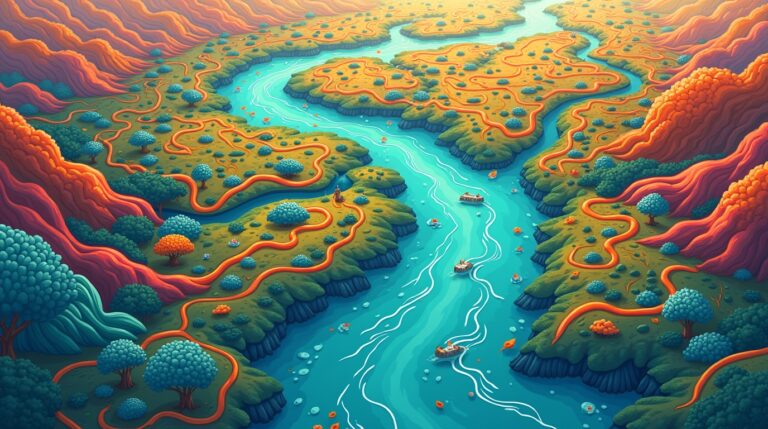The city of Atlantis first emerges from the dialogues of the ancient Greek philosopher Plato, specifically in “Timaeus” and “Critias,” written around 360 BCE.
In these texts, Plato describes Atlantis as a powerful and advanced civilization that ultimately falls out of favor with the “gods” and sinks into the ocean in a single day and night of catastrophe. The story is presented through a narrative passed down from Solon, an Athenian statesman who reportedly learned of Atlantis from Egyptian priests during his travels to Egypt around 590 BCE.
These priests claimed that Atlantis existed some 9,000 years before their time, positioning the civilization to have thrived around 9,600 BCE. The described location of Atlantis was beyond the “Pillars of Hercules,” which is commonly identified as the modern-day Strait of Gibraltar, suggesting a vast island or continent in the Atlantic Ocean that was larger than Asia and Libya combined.
(In this other article, I explained how time “contracted” throughout history because of sin, so that aging becomes faster and people die younger. This would explain why they might’ve come up with these numbers of “9,000 years before their time” which clearly seem to contradict the Torah that Creation is only 5784 years at the time of this article).
Despite its vivid description by Plato, including the layout of the central city surrounded by concentric rings of water and land, and its portrayal as a hub of naval power and cultural sophistication, most historians and scholars consider Atlantis to be a fictional narrative created by Plato. The tale is thought to serve as a moralistic fable, warning of the consequences of corruption and arrogance.
Over time, however, the story of Atlantis has persisted and evolved, inspiring a wide range of artistic and literary works, as well as speculative theories about its real-world location and historical basis.
The Torah and Atlantis
I’m of the position that much of history as we learn lacks context, is twisted, or is simply false. The only anchoring and absolute source of truth is the Torah, which includes the Tanach, the Talmud, the Zohar and the Kabbalah. So I am open to the possibility that the ancient city of Atlantis actually existed before the floor. It makes a lot of sense as we will soon see.
It turns out that Noach’s flood was the second watery disaster to inundate humanity. Generations earlier, Hashem had prewarned the world of Noach’s flood by plunging a third of its land mass underwater (Rashi, Bereshit 6:4). Yet the Chumash dismisses this calamitous event in a couple of words. And unlike Noach’s flood that was recorded by many civilizations, only one historical source breathes a word about the earlier deluge.
Despite the sparse sources of this event, hordes of people have speculated the whereabouts of the drowned continent. In more recent times, the story even provided fodder for Nazi racial propaganda.
With three cryptic words, the Chumash hints that the generation of the flood was warned ahead of time that evil behavior is the root of destruction. Telling us of the giants who took the daughters of men, the Torah says, The giants were in the land in those days and also afterwards (Bereshit 6:4). Rashi explains these mysterious words as follows: “Even though they saw the destruction of the generation of Enosh when the ocean rose and flooded a third of the world, the generation of the flood was not humbled to learn from them.”
Rashi’s source, the Midrash Tanchuma, does not add much to our stock of information. Yalkut Sippurim, a collection of Chazal and midrashim printed in 1906, adds one detail: the lost land mass was adjacent to a river: “Hashem flooded them with the waters of the Gichon River (from Gan Eden) and destroyed them and eradicated them, and destroyed a third of the land.”
This gives credence to the latest search for the lost land that we’ll discuss later.
In Timaeus, Plato describes the event in the following terms:
“Many great and wonderful deeds are recorded of your state [Athens] in our [the Egyptian’s] histories. But one of them exceeds all the rest in greatness and valor. For these histories tell of a mighty power [Atlantis], which unprovoked made an expedition against the whole of Europe and Asia, and to which your city put an end.
After relating how Atlantis attacked the rest of the world and suffered defeat, Plato describes its sudden destruction:
“Afterwards there were violent earthquakes and floods, and in a single day and night of misfortune. the island of Atlantis disappeared in the depths of the sea. For this reason, the sea in those parts is impassable and impenetrable; for there is a shoal of mud in the way caused by the subsidence of the island.”
In his other work Critias, Plato describes Atlantis in detail, writing, among other things, that the country’s principal city was a seaport consisting of concentric circles of rock with an island in the middle. Similar to his other account, he writes that lawlessness, ambition, and power lust led to Atlantis’s downfall.
Ever since, people were never certain whether Plato’s story of a vast submerged kingdom was fact or fantasy. Some people brushed it off as a parable, while others tried guessing where the mysterious land might be located and where its survivors may have fled. Interest in Atlantis increased with the passing of time. In modern times, as explorers began poking in every nook and cranny of the world, fascination in the lost continent rekindled.
One of the earliest modem researches was conducted by the Swedish anatomist, botanist, and university rector, Olaus Rudbeck. From 1679 onwards, he began publishing a four-volume work aptly titled Atlantica. He proposed that Atlantis was located in the vicinity of Sweden and that its survivors had transformed Sweden into the cradle of civilization.
Isaac Newton’s 1728 The Chronology of Ancient Kingdoms, also discussed Atlantis at length, while 19th century scholars associated Atlantis with Mayan and Aztec culture. Best know of the Atlantis theorists was US congressman, Ignatius L. Donelly, whose book, The Antediluvian World ambitiously set out to prove, among other things:
“That there once existed in the Atlantic Ocean, opposite the mouth of the Mediterranean Sea, a large island, which was the remnant of an Atlantic continent, and known to the ancient world as Atlantis… That it became, in the course of ages, a populous and mighty nation, from whose overflowings the shores of the Gulf of Mexico, the Mississippi River, the Amazon, the Pacific coast of South America, the Mediterranean, the west coast of Europe and Africa, the Baltic, the Black Sea, and the Caspian were populated by civilized nations.”
The amount of surmise people have cooked up from a few lines of Plato is enough to fill a dozen Atlantises. By now, theorists have dreamt up no fewer than twenty potential sites of the missing continent.
What this means for us and what does this have to do with Kabbalah?
As I mentioned before, there’s a huge gap between what we are told and how things actually happened. Apart from actually knowing history which I find important, there’s a great need to dispel the fallacy that we “are wiser” or more “technologically advanced” than the previous generations.
It’s just that, like the flood (which fits almost perfectly with Atlantis’ tale), much of our technologies and powers of the mind were lost. Instead we have nowadays an over-emphasis (almost to the point of idolatry) of science, which lead to the breeding of this “daas Torah and rational judaism” brands of pseudo-Judaism where fake rabbis try to explain away the Torah and its miracles in order not to “offend anyone.
After all, we all “evolved”
It should be enough to see that science still has no clue how pyramids were built, how so many unheard diseases suddenly appeared (and no one can seem to treat them), how it still dismisses to a great extent the power of experiential wisdom (Chokhmah), and refuses to acknowledge the existence of Hashem and his ever-present providence in Creation, as written in the Torah.
(And no, the pyramids weren’t mere tombs for the Pharaos)
The ancient Jews and non-Jews knew a lot more than we can possibly imagine in ever conceivable field but that is something that we will need to address in another post.
This open state of mind is actually a pre-requisite to actually be able to absorb the incredibly deep spiritual wisdom of Kabbalah: it’s only if we can hold within us all these doubts, contradictions and questions for a sufficient enough time, can we ever hope to begin to grasp it.
It takes time and willingness to accept that a lot of things we previously thought were true, are in fact false.
The latest dig on the enigma
In recent years, Atlantis has become a subject of intense interest to serious archeologists. Some propose that its capital was located on the Greek island of Santorini, others favor the Italian island of Sardinia, while others stake their money and reputation on Cyprus.
The fascination with Atlantis was significantly reignited in the modern era by Ignatius Donnelly, a former U.S. Congressman, who in 1882 published “Atlantis: The Antediluvian World.” Donnelly proposed that Atlantis was a real place that had been the source of all ancient civilizations. His hypotheses, inspired by the discovery of the city of Troy—a location long thought fictional until its archaeological unearthing—suggested that Atlantis, too, could be discovered. This led to a surge in Atlantology, with various theories and expeditions attempting to locate the lost civilization
Biblical archeologist, Professor Richard Freund, director of the Maurice Greenberg Center for Judaic Studies and the Maurice Greenberg Professor of History at the University of Hartford, claimed that there is evidence that the ancient city of Atlantis is buried deep under the marshlands of the Donana National Park in Southern Spain just north of Cadiz.
Explorers began looking at the 250-square-mile park in the 1920s. Satellite photos taken in 1992 and reexamined in 2003 revealed circular patterns on the park’s mudflats that investigators regarded as startlingly reminiscent of Plato’s destruction of Atlantis’ circular town and harbor. Freud argued that Plato’s placing of Atlantis near the Pillars of Hercules, generally understood to be the Straits of Gibraltar, adds more credit to his thesis. In addition, Plato remarks that Atlantis faced a city called Gadara, which is an ancient name for modern Cadiz in Southern Spain.
On top of that, Freund points out that a number of ruins in the area have the same
concentric-circles shape as Atlantis’s port city. He contends that they are memorial cities built by survivors of the catastrophe. Furthermore, forty-five feet borings in the park vicinity unearthed fragments of wooden boats going back almost five thousand years.
Since the burst of publicity in March, not too much has been written about Freund’s exploits and he admits that subsurface groundwater will make digging dozens of feet down to the purported site a formidable undertaking. If he does unearth the evil city, it will be a living memorial to one of the greatest Divine punishments ever to strike mankind.
May we merit to reveal the true power of our souls and experience Hashem’s revelation.







